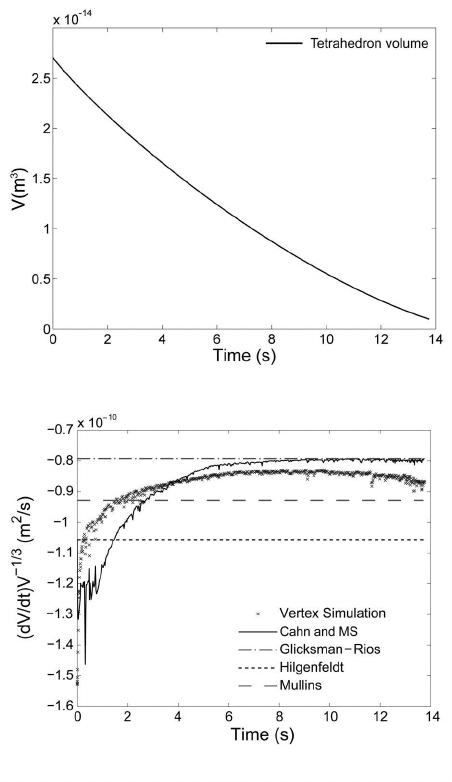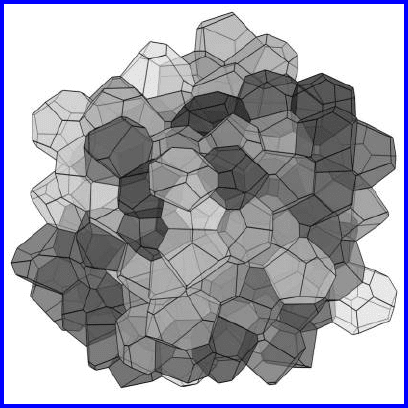Gottstein G., Shvindlerman L.S. Grain Boundary Migration in Metals: Thermodynamics, Kinetics, Applications
Подождите немного. Документ загружается.


4.7 Grain Growth in 3D Systems 415
total curvature κ
T
. The average curvature ¯κ
p
can also be expressed as
¯κ
p
=
1
L
(ΔΘ) (4.106)
where ΔΘ gives the change in the direction of the tangent to the end of
the curve considered (Θ = arc tan(y
)). For a closed curve ΔΘ = ± 2π and
¯κ
p
= ±2π/2. In accordance with [553] ¯κ
p
is positive for the concave curve and
negative for the convex curve.
Then for a given grain
dV
dt
= −m
b
γ
∂D
HdA = −2πm
b
γ
L(D) −
1
6
e(D)
(4.107)
or if the volume of the grain is known at any time
dV
dt
V
−1/3
= −2πm
gb
γ
L(D) −
1
6
e(D)
· V
−1/3
(4.108)
As the Von Neumann-Mullins relation, the new relation (Eq. (4.108)) depends
only on the geometrical characteristics of the grain.
However, contrary to the Von Neumann-Mullins relation Eq. (4.104) is not
purely topological. The rate of grain volume change depends on the mean
width of the grain and the total length of the triple junctions. However, it
does not depend distinctly on the shape of the grain. If the right-hand side of
Eq. (4.104) is proportional to the grain size then the kinetics of grain growth
are governed by a parabolic law.
It is stressed that all approaches so far considered assumed (tacitly [545]–
[551], or explicitly [552]) that grain boundaries move slowly enough to main-
tain the equilibrium dihedral angles at triple junctions. In other words, the
mobility of all junctions is assumed to be infinite.
For an isolated convex polyhedral grain with curved faces bounded by sharp
edges the total curvature κ
T
is equal to κ
T
=
1
2
¯
ΔΘL +¯κ
s
S =2π
¯
D where
κ
s
is the average mean curvature of just the grain surfaces (faces), ΔΘ is the
complement of the average dihedral edge angle, S is the total area and L is
the edge length. Then
¯κ
s
=
2π
s
¯
D −
¯
ΔΘ
4π
L
(4.109)
For the particular case of polyhedra with flat faces κ
s
is zero and the caliper
diameter
¯
D is equal to
¯
D =
¯
ΔΘ
4π
L. Cahn’s equation can be considered a par-
ticular solution of the general Eq. (4.104). In what follows the approach based
on relation (4.104) will be called the Cahn-MacPherson-Srolovitz relation.
© 2010 by Taylor and Francis Group, LLC

416 4 Thermodynamics and Kinetics of Connected Grain Boundaries
(a) (b) (c)(a) (b) (c)
FIGURE 4.60 (SEE COLOR INSERT FOLLOWING PAGE 424)
Configurations used for the simulation of the diverse analytical expressions
corresponding to (a) a 3-sided grain, (b) a tetrahedral grain and (c) a hexag-
onal prismatic grain. The grains surrounding these grains and forming the
granular aggregates are not shown. The case of the hexagonal prism is special
since it is surrounded by other hexagonal prisms and thus presents steady-
state motion of its grain boundaries [554].
4.7.2 Computer Simulations of 3D Grain Growth
4.7.2.1 Solitary Grains
In [554] a three-dimensional vertex model was utilized to study grain growth
in 3D systems and to analyze how the aforementioned approaches represent
reality.
Contrary to the 2D situation the details of grain growth in 3D systems can
be quantitatively studied only by computer simulations since the techniques
for continuous characterization of 3D grain structures are still at their infancy.
The problem was considered in two stages. Firstly, the grain growth of a
single grain was examined and the results were compared quantitatively with
analytical approaches developed by MacPherson and Srolovitz [552]. In the
second stage the kinetics of grain growth in 3D polycrystals obtained by com-
puter simulations were compared to analytical predictions [541, 542, 554].
Three simple singular grain shapes were considered in [554] (Fig. 4.60). Al-
though these configurations are unlikely to be found in a normal polycrystal
(the tetrahedron is an exception) their simplicity makes them a good subject
to test the different approaches discussed above.
We would like to stress again that the Cahn-MacPherson-Srolovitz ap-
proach is the only one that considers the metrics of the grains, which change
dynamically in the course of grain growth. As a result this approach predicts
a non-constant time dependency of the normalized volume rate of change
(
˙
VV
−1/3
). All other models depend only on the topological class and thus
predict a constant value of (
˙
VV
−1/3
). Comparison of the Cahn-MacPherson-
Srolovitz approach with experimental results is somehow complicated because
the parameters of this approach have to be determined from the current ge-
© 2010 by Taylor and Francis Group, LLC

4.7 Grain Growth in 3D Systems 417
FIGURE 4.61
A hexagonal prismatic grain and the two dimensions a and d are shown [542].
ometry of the grains. A vertex model allows us to define all the parameters for
this calculation during the evolution of the volume of a grain. In the following
we will explain more comprehensively how the Cahn-MacPherson-Srolovitz
relation (4.104), (4.108) can be computed from the simulated microstructure
[554].
For this we consider the example of a hexagonal prismatic grain [542]
(Fig. 4.61)
L(D)=
1
2π
n
ef
i
β
i
e
i
(4.110)
e(D)=
n
tj
i
e
tj
i
(4.111)
The term e(D) is the length of the triple junctions of a given grain and is
equal to the sum of the length of all triple lines N
tj
of such a grain.
The term L(D) reflects the local variation of the surface with respect to
a fixed reference. To better understand this we need to imagine that the
surface is also divided into very small surface elements. The normal to each
element of the surface dS characterizes its spatial orientation, which may
be different from all other pieces of surface surrounding the element dS;the
angle β is known as the turning angle and represents precisely the variation
of one surface element with respect to another. The term e
i
in Eq. (4.110)
comprises the length of the junction between the dS elements. The sum over
all junctions n
ef
corresponds to the mean width of the whole domain. The
orientation difference β across a triple junction corresponds to the external
dihedral angle which in the equilibrium is established by the surface tensions
of the adjoining grain boundaries. Another interesting feature of this term is
that it introduces implicitly the curvature of the surface in Eq. (4.104).
As an example in Fig. 4.61 two new variables, a and d, define the dimensions
of the grain: d is the length of the longitudinal triple line grain and a is the
length of a side of the hexagonal cross section; the curvature of the triple line
© 2010 by Taylor and Francis Group, LLC

418 4 Thermodynamics and Kinetics of Connected Grain Boundaries
is included in this parameter. Now we can calculate first the term e(D)for
this grain as follows:
e(D)=
n
tj
i
e
tj
i
=6d +12a (4.112)
the term L(D) can also be easily calculated:
L(D)=
1
2π
n
ef
i
β
i
e
i
=
1
2π
2L
k
+
1
3
π · 6d +
1
3
π · 12a
=
L
k
π
+d+2a (4.113)
where L
k
is the unknown mean width of the two curved grain boundaries of
the grain. Because all other grain boundaries are flat, β = 0 and their surfaces
do not contribute to the mean width.
From Eqs. (4.105), (4.112) and (4.113), we arrive at
dV
dt
= −2πm
b
γ
L
k
π
+ d +2a − d − 2a
= −2m
b
γL
k
(4.114)
The volume change rate for the configuration considered is determined by the
term L
k
which represents only the curved grain boundaries. It can be seen
that Eq. (4.114) delivers a constant rate dV/dt and complies with reality since
the configuration in Fig. 4.61 demonstrates a steady-state evolution of its vol-
ume.
In order to compare the different approaches the volume rate of change was
normalized by the cubic root of the volume of the grains at any time, and for
the case of the Cahn-MacPherson-Srolovitz approach Eq. (4.108) was used.
Fig. 4.62 shows the temporal evolution of the volume and the normalized
volume rate of change for a 3-sided grain (Fig. 4.60). The volume is seen to
decrease non-linearly with time (Fig. 4.62) indicating that, as predicted by
Eqs. (4.104) and (4.108), there is not a constant volume rate of change (
˙
V )
for a particular topological class. Since the parameters in Eq. (4.104) change
with time,
˙
V cannot have a constant value unless special conditions are met
as in the case of the hexagonal prism [542]. The normalized volume rate of
change (Fig. 4.62b) also does not seem to be constant with time. A compar-
ison of
˙
VV
−1/3
for the different approaches evidences best agreement of the
simulations with the Cahn-MacPherson-Srolovitz approach Mullins’ model
(Eq. (4.99)) also yields reasonable agreement. This indicates that the expres-
sion
˙
VV
−1/3
of this particular grain is not far from the mean of the topological
class n = 3. The models of Hilgenfeldt et al. [545] and Glicksman-Rios [551]
cannot deliver a value for the topological class n = 3 since Eqs. (4.102) and
(4.103) become undetermined for this number of grain faces.
The evolution of the tetrahedral grain shows similar features, a non-linear
dependency of the volume on time (Fig. 4.64) and, consequently, a non-
constant
˙
V ; however,
˙
VV
−1/3
is closer to a constant value (Fig. 4.64b). As
in the previous case, the agreement with Eq. (4.108) is good. The observed
© 2010 by Taylor and Francis Group, LLC

4.7 Grain Growth in 3D Systems 419
(a)
(b)
(a)
(b)
(a)
(b)
FIGURE 4.62
Volume evolution with time (a) and comparison of the volume rate of change
of a 3-sided grain with the different model as calculated from the simulation
data. (b) The Hilgenfeldt and Glicksman-Rios models do not appear because
the volume rate of change of a grain with a topological class n = 3 cannot be
calculated with their approaches (Eqs. (4.102) and (4.103) become undeter-
mined [554]).
© 2010 by Taylor and Francis Group, LLC

420 4 Thermodynamics and Kinetics of Connected Grain Boundaries
FIGURE 4.63
Reuleaux tetrahedron.
deviations in the beginning of the simulation are caused by the fact that the
starting configurations have flat grain boundaries and thus need a certain re-
laxation time to attain the necessary curvature and equilibrium at the triple
lines. The tetrahedral grain is of special interest for the Glicksman-Rios model
[551]; the point is that the tetrahedral grain has a particular geometry, since
it resembles a Reuleaux tetrahedron that is formed by the intersection of four
spheres of equal radius with centers located at the surfaces of the neighboring
spheres (three-dimensional equivalent of the Reuleaux triangle (Fig. 4.63)).
This geometry is optimal to study the Glicksman-Rios approach [551] be-
cause during its evolution it meets the condition of a constant vertex-to-vertex
distance λ
4
that is assumed in this model, and thus Eq. (4.103) represents an
exact solution for the growth rate of this grain. The simulation results show, in
fact, excellent agreement with this model. The Hilgenfeld and Mullins models
[545] also show reasonable agreement.
As shown in [542] the evolution of a hexagonal prism takes place in the
steady-state regime and
˙
V = const. Fig. 4.65 shows the calculated parameters
L(D)ande(D) taken directly from the geometry of the evolving grain [542].
For a grain which evolves in a steady-state regime (
˙
V = const) the curves
L(D, t)ande(D, t) need to be parallel (Eq. (4.104). One can see that this
condition is evidently fulfilled (Fig. 4.65).
The results for the hexagonal prism (Fig. 4.66) show that the Cahn-
MacPherson–Srolovitz approach [552] is the only one that reproduces almost
exactly the evolution of the mean volume rate of change of the prism whereas
other approaches deviate from the simulation results since they can only ren-
der a constant value, yet, on average with reasonable agreement. It is also
confirmed that neither a constant
˙
V nor a constant
˙
VV
−1/3
can be expected
for a given topological class because of the dependency of the growth rate
on the metrics of the grain. For the 3-sided and tetragonal grain a constant
© 2010 by Taylor and Francis Group, LLC

4.7 Grain Growth in 3D Systems 421
(a)
(b)
(a)
(b)
FIGURE 4.64
Volume evolution with time (a) and comparison of the volume rate of change of
a tetrahedral grain using the different models as calculated from the simulation
data (b) [554].
© 2010 by Taylor and Francis Group, LLC

422 4 Thermodynamics and Kinetics of Connected Grain Boundaries
FIGURE 4.65
The temporal evolution of the parameters L(D)ande(D) for a hexagonal
prism [554].
˙
V cannot be achieved. It is be stressed that even in these cases a constant
˙
VV
−1/3
is highly debatable since any perturbation in the geometry of the
grains from the assumed ones will lead to deviations from the expected val-
ues. The hexagonal prism shrinks at constant
˙
V and, therefore, cannot deliver
a constant
˙
VV
−1/3
.
The analysis of the data of Fig. 4.66b reveals another interesting feature.
The deviation between the Cahn-MacPherson-Srolovitz relation and the nor-
malized volume rate of change remains constant for the entire simulation (with
the exception of the incipient relaxation time). This occurs because the area
of the grain boundaries that provides the driving force for the reduction of
the volume of the grain does not change and, accordingly, the surface is rep-
resented by about the same quantity of triangular facets. Thus, the numerical
error remains constant. The reduction of the grain boundary area and, hence,
of the free energy, occurs at the expense of the lateral flat grain boundaries
of the grain.
The results presented demonstrated that the Cahn-MacPherson-Srolovitz
relation 4.104 delivers the best description for the curvature-driven grain vol-
ume change under specific controlled conditions. Despite the simplicity of the
configurations studied, the results indicate that a grain of a given topological
class can only shrink or grow with a constant
˙
VV
−1/3
or
˙
V under special
conditions. The volume rate of change of normal closed domains for constant
topological class will scatter over a certain range depending on the change
in the metrics of the grain L(D)ande(D) in Eq. (4.104) until a topological
transformation occurs that changes the topological class of the grain.
© 2010 by Taylor and Francis Group, LLC

4.7 Grain Growth in 3D Systems 423
(a)
(b)
(a)
(b)
FIGURE 4.66
Volume evolution with time (a) and comparison of the volume rate of change
of a hexagonal prismatic grain predicted by different models and simulation
data (b) [554].
© 2010 by Taylor and Francis Group, LLC

424 4 Thermodynamics and Kinetics of Connected Grain Boundaries
FIGURE 4.67 (SEE COLOR INSERT FOLLOWING PAGE 424)
Polycrystal used in the simulation composed of 125 grains with periodic
boundary conditions [554].
4.7.2.2 3D Polycrystals
In the previous section we considered how the results of computer simula-
tions of the temporal evolution of the volume of solitary grains compare to
the different analytical approaches [541, 542, 554]. However, the behavior of
a single grain is not the major goal of the approaches discussed. The main
objective is to find a key to describe the grain growth in 3D polycrystal, to
compute the rate of change of the volume of the grains in complex grain as-
semblies. This problem was considered in [554], where the grain growth in
a polycrystal composed of 125 grains (Fig. 4.67) was studied quantitatively.
The volume rate of change of all grains showed very good agreement with
the Cahn-MacPherson-Srolovitz relation. In Fig. 4.68, an example of three
grains with different growth rates is shown. During growth the grains suffer
topological changes by gaining and losing grain boundaries [554]. One can see
that the volume rate of change
˙
V is apparently affected less by the change
in the topological class than by the change in the metrics of the grains as
substantiated also by the good agreement of the Cahn-MacPherson-Srolovitz
relation with simulation results. In ([554]) it was shown that the evolution
of individual grains and grain growth in polycrystal are well described by
the Cahn-MacPherson-Srolovitz relation. An agreement between this relation
© 2010 by Taylor and Francis Group, LLC
